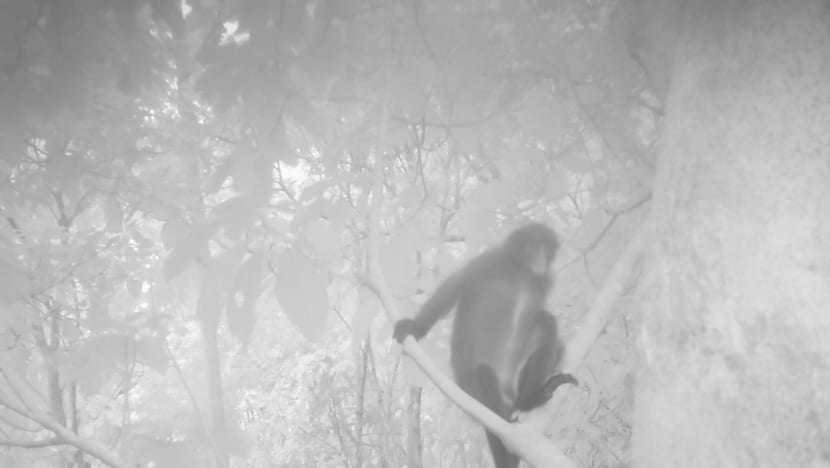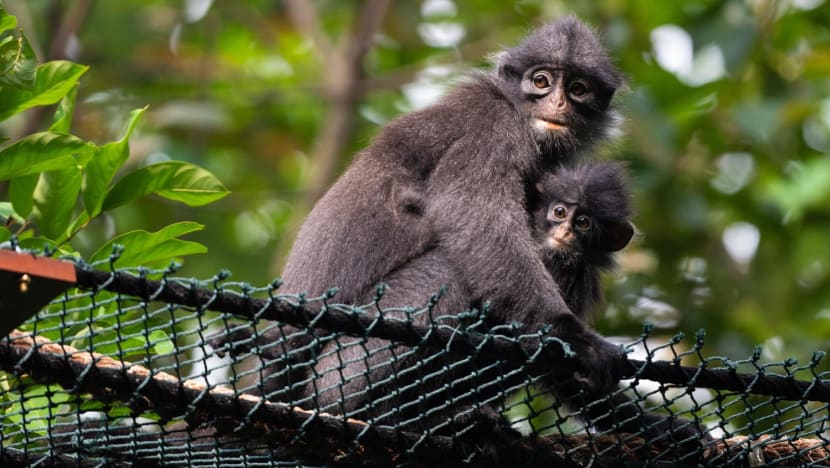Critically endangered monkey spotted on Singapore eco bridge, suggesting species could be expanding habitat
The sighting of a Raffles' Banded Langur on the Eco-Link@BKE suggests the monkeys - known to only reside in the Central Catchment Nature Reserve - may be expanding their habitat to the Bukit Timah Nature Reserve.
.jpg?itok=mikdD0kk)
A composite image of Eco-Link@BKE and the Raffles' Banded Langur that was spotted there. (Photos: NParks, CNA)

This audio is generated by an AI tool.
SINGAPORE: Critically endangered monkeys last seen in Bukit Timah Nature Reserve more than 35 years ago could be making their way back to that area, after at least one of these primates was sighted on an ecological bridge.
The Raffles' banded langur was spotted on cameras placed on the Eco-Link@BKE on two separate occasions in October 2023, said the National Parks Board (NParks) on Thursday (Apr 25).
The bridge, opened in 2012, connects the Bukit Timah and Central Catchment Nature Reserves, which were separated after the construction of the Bukit Timah Expressway (BKE) in 1986.
A year later, the Raffles' banded langur was spotted for the last time in Bukit Timah Nature Reserve. The langurs are now known to only reside in the Central Catchment Nature Reserve.
This species, whose scientific name is Presbytis femoralis, is native to Singapore and the southern Malaysian peninsular. As of 2021, only 68 individuals had been recorded in the wild in Singapore.
OCTOBER SIGHTING
On the evening of Oct 16, 2023, a Raffles' banded langur was captured by a camera trap placed on a Sterculia tree about 10m above the ground. The camera captured the monkey sitting on a branch looking directly at the camera.
The monkey appeared to be scratching itself and looking around before moving off from the branch. Three days later, at 4.30pm on Oct 19, the Raffles' banded langur was spotted again at the same branch. NParks said it was unsure if it was the same monkey.

The sightings are an "encouraging" sign that the species is possibly using the ecological bridge to expand its range and habitat, said NParks. This gives the Raffles' banded langur a higher chance of survival as it is believed that the last stronghold for this species was at the Central Catchment Nature Reserve.
"It also highlights the significance of implementing wildlife crossing aids to enhance ecological connectivity for our native wildlife to thrive," added NParks.
Allowing wildlife to interact between the two nature reserves prevents genetic isolation and promotes a bigger spread of their genetic pool, said NParks. This cuts down on inbreeding and gives the species a higher chance of survival.

Minister for National Development Desmond Lee called this "very exciting news".
"While numbers of this rare Raffles banded langurs hit a low of around 10 in the 1980s, it has grown to around 70 individuals today," he said in a Facebook post on Thursday.
"To ensure that our native wildlife can thrive, NParks is working closely with Raffles’ Banded Langur Working Group to protect our Raffles’ banded langur population."
















